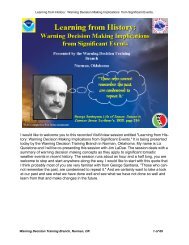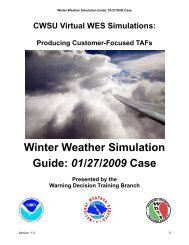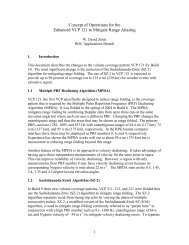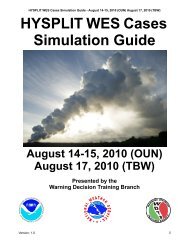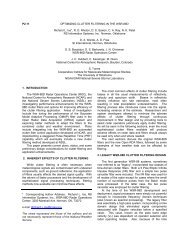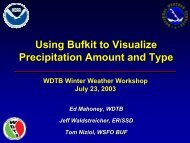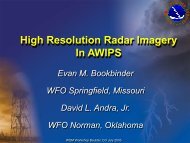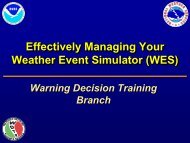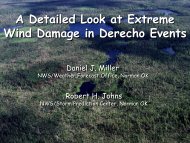Challenges of Forecasting in the West - NOAA
Challenges of Forecasting in the West - NOAA
Challenges of Forecasting in the West - NOAA
You also want an ePaper? Increase the reach of your titles
YUMPU automatically turns print PDFs into web optimized ePapers that Google loves.
<strong>Challenges</strong> <strong>of</strong> <strong>Forecast<strong>in</strong>g</strong><strong>in</strong> <strong>the</strong> <strong>West</strong>Brad Colman, Sc.D.<strong>NOAA</strong>/National Wea<strong>the</strong>r ServiceSeattle, WA
Wea<strong>the</strong>r <strong>Forecast<strong>in</strong>g</strong>:The process <strong>of</strong> <strong>in</strong>ferr<strong>in</strong>g sensible wea<strong>the</strong>rfrom a blend <strong>of</strong> data, understand<strong>in</strong>g,climatology, and solutions <strong>of</strong> <strong>the</strong>govern<strong>in</strong>g equations.
Overview <strong>of</strong> human-based forecast<strong>in</strong>gI. Forecasters require an analysis <strong>of</strong> <strong>the</strong> current situationand <strong>the</strong> form<strong>in</strong>g <strong>of</strong> an hypo<strong>the</strong>sis about how <strong>the</strong> currentwea<strong>the</strong>r came to be. This is an absolute necessity.II.Forecasters also require a set <strong>of</strong> physical models withwhich to build <strong>the</strong>ir hypo<strong>the</strong>sis. These arephenomenological conceptual models, which are:a. concepts <strong>of</strong> atmospheric processes, and how <strong>the</strong>y aremanifest <strong>in</strong> <strong>the</strong> operational data stream, andb. physical models formed through a mixture <strong>of</strong> <strong>the</strong>ory,experience, and climatology.GOAL: Maximize human capacity for perception <strong>of</strong>processes, and m<strong>in</strong>imize <strong>in</strong>correct judgment.
REMOTE SENSINGSATELLITERADAROTHERS….UPPER AIRDATASURFACE DATASUBJECTIVEANALYSISOBJECTIVEANALYSISPHYSICALMODELSINITIALIZATIONDIAGNOSISNUMERICALMODELSMETHODS FOR TRENDPERSISTENCECLIMATOLOGYPATTERN RECOGNITIONDECISION TREESMODEL OUTPUTMOSMOSIFPS/GFE
Historically <strong>in</strong> <strong>the</strong> <strong>West</strong> <strong>the</strong>se havebeen <strong>the</strong> mesoscale structures notcaptured by synoptic-scale models• Unique to <strong>the</strong> <strong>West</strong> are many forced mesoscalecirculations.• Most local forecast adjustments are done <strong>in</strong> al<strong>in</strong>ear fashion. I.e., take <strong>the</strong> synoptic forc<strong>in</strong>g and<strong>the</strong>n add <strong>the</strong> mesoscale structure.• Models are beg<strong>in</strong>n<strong>in</strong>g to capture many <strong>of</strong> <strong>the</strong>larger mesoscale features – both good and bad.
Mesoscale Meteorology“….<strong>the</strong> study <strong>of</strong> more or less ubiquitousenergy transfer processes and <strong>the</strong> specialevents that occur locally and <strong>in</strong>termittentlyas a result <strong>of</strong> topographic forc<strong>in</strong>g andmesoscale <strong>in</strong>stabilities.”(Emanuel, 1986)
Categorize mesoscale circulations<strong>in</strong>to two types:1. Free (<strong>in</strong>ternal) circulations/disturbances:• Occur as a result <strong>of</strong> an <strong>in</strong>stability <strong>in</strong>herent with<strong>in</strong> <strong>the</strong> fluid (someprecip bands, MCCs, jetstreaks, polar lows, squall l<strong>in</strong>es,hurricanes)• To predict, look at “background” flow to determ<strong>in</strong>e what <strong>in</strong>stabilitiesmay be present2. Forced circulations/disturbances:• Owe <strong>the</strong>ir existence, at least <strong>in</strong> part, to an external boundary <strong>of</strong> <strong>the</strong>system• External forc<strong>in</strong>g controls location and <strong>in</strong>fluences <strong>the</strong> scale <strong>of</strong> <strong>the</strong>system• To predict, need to be familiar with local physiographic featuresand complicated mesoscale dynamics
1. Free (<strong>in</strong>ternal) circulations/disturbances:• Precipitation bands (CSI, etc.)• Convective complexes• Polar lows• Squall l<strong>in</strong>es• Gravity waves2. Forced circulations/disturbances:• Blocked flow events• Lake-effect snowstorms• Terra<strong>in</strong>-modulated w<strong>in</strong>d and convergence bands• Gravity waves No consistent approximation to <strong>the</strong> full primitive equations covers allmesoscale phenomena (as quasigeostrophy does for synoptic-scalemotions)
Simple Geostrophic Flow10341030102610221018L RL R = hNf
Basic <strong>Forecast<strong>in</strong>g</strong> ApproachesI. Objective techniques:a. Numerical models – perfect prog approachb. Statistical approachesII.Subjective (human-based) techniques:a. Decision treesb. Empirical rulesc. Synoptic climatologies
Objective techniques:a. Numerical models – perfect prog approach:a. Critically dependent upon grid resolutionb. Will play a greater role <strong>in</strong> IFPS/GFE environmentc. Have complicated biases and limitationsb. Statistical approaches:a. MOS is our best known exampleb. Simple spatial corrections can be developedc. Can capture sub-grid processesd. Powerful tool that should be gett<strong>in</strong>g more attentione. Loses context <strong>of</strong> physical model
Decision trees:• Organize <strong>the</strong> mental processes <strong>of</strong> a forecaster• Represent a comb<strong>in</strong>ation <strong>of</strong> subjectivity andobjectivity• Often use parameter values, or pattern recognition(Our example: Enumclaw w<strong>in</strong>dstorms)
Empirical techniques:• Typically result from a local study• Should be physics-based (although <strong>of</strong>ten are not)• Need to be re-evaluated on a regular basis(Our example: gap w<strong>in</strong>ds)
Synoptic climatologies:• A specific type <strong>of</strong> local study• Represents a composite <strong>of</strong> a large number <strong>of</strong>cases (at least ~20)• Helps identify salient features• Must be comb<strong>in</strong>ed with phenomenologicalconceptual models to ensure correct physics anddynamics(Our example: Taku w<strong>in</strong>ds)
<strong>Forecast<strong>in</strong>g</strong> <strong>in</strong> <strong>the</strong> <strong>West</strong> is:• Focus<strong>in</strong>g on scale <strong>in</strong>teractions and processes• Deal<strong>in</strong>g with free and forced mesoscale circulations that<strong>in</strong>fluence:– Precipitation distribution and type– Temperature extremes– W<strong>in</strong>d direction and speed– Cloud characteristics• NOT l<strong>in</strong>ear and requires conceptual models that arephysics based• Requires a cont<strong>in</strong>ual re-evaluation <strong>of</strong> tools and modelsas improvements <strong>in</strong> NWP gradually resolve <strong>the</strong>important mesoscale structure• And, this must all be done <strong>in</strong> an environment with<strong>in</strong>ferior upstream <strong>in</strong>itial conditions.



